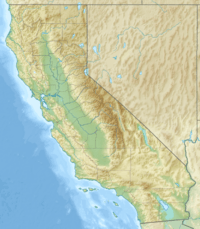Murrieta Hogbacks facts for kids
Quick facts for kids Murrieta Hogbacks |
|
|---|---|
| Highest point | |
| Elevation | 1,781 ft (543 m) |
| Prominence | 341 ft (104 m) |
| Geography | |
| Location | Riverside County, California, U.S. |
| Parent range | Temescal Mountains |
| Topo map | USGS Murrieta, CA |
| Geology | |
| Age of rock | Cretaceous, Miocene |
| Mountain type | Granitic, Basalt |
The Murrieta Hogbacks are a group of interesting hills found in northeastern Murrieta. They are located at the southern end of the Temescal Mountains in Riverside County, California. These hills are special because of their unique shape and the types of rocks they are made of.
Contents
What are Hogbacks?
A hogback is a type of hill or ridge that has a steep slope on both sides. It looks a bit like the back of a hog (a pig), which is how it got its name! The Murrieta Hogbacks are made of hard rock that has resisted erosion over millions of years. This makes them stand out from the softer land around them.
The Rocks of Murrieta Hogbacks
The Murrieta Hogbacks are mostly made of two main types of rock:
- Basalt: This is a dark, fine-grained volcanic rock. It forms when lava cools quickly. At the Murrieta Hogbacks, the basalt forms a cap, meaning it sits on top of other rocks.
- Granite: This is a light-colored, coarse-grained rock. It forms deep underground from slowly cooling magma. The granite here is part of a very large rock formation called the Peninsular Ranges Batholith.
How the Hogbacks Formed
The basalt rock on top of the Murrieta Hogbacks is quite old. Scientists have used a method called potassium-argon dating to find out its age. They found it is about 10.4 to 10.8 million years old. This means the basalt formed during the Miocene Epoch, a time period in Earth's history.
This basalt was once a lava flow that filled an ancient river channel. Imagine a river flowing millions of years ago, and then lava poured into it, filling up the riverbed. Over time, the softer rocks around this lava-filled channel eroded away. But the hard basalt remained, creating the hogback shape we see today. Beneath the basalt, there are older Cretaceous granitic rocks. These rocks formed even earlier, around 65 to 145 million years ago.
Types of Granitic Rocks
The granitic rocks under the hogbacks are not all exactly the same.
- On the northern part of the hogbacks, you'll find a rock called foliated biotite-hornblende tonalite. This is a type of granite that has layers (foliation) and contains minerals like biotite and hornblende.
- On the southern part, there is hornblende gabbro. Gabbro is another type of igneous rock, similar to basalt but formed deep underground. It also contains the mineral hornblende.
These different rock types tell a long story about how the area was formed over millions of years, from ancient lava flows to deep underground rock formations.


